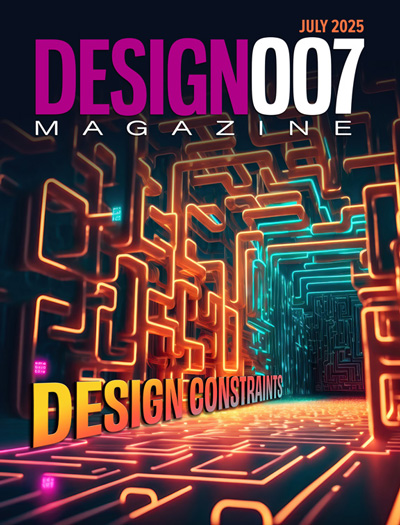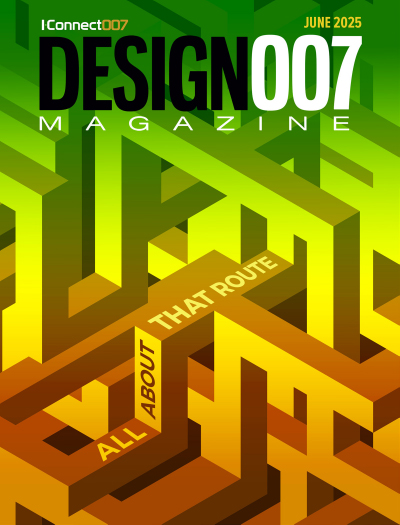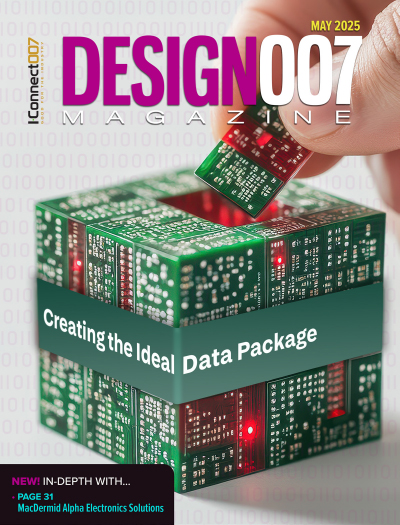-

- News
- Books
Featured Books
- design007 Magazine
Latest Issues
Current Issue
Showing Some Constraint
A strong design constraint strategy carefully balances a wide range of electrical and manufacturing trade-offs. This month, we explore the key requirements, common challenges, and best practices behind building an effective constraint strategy.

All About That Route
Most designers favor manual routing, but today's interactive autorouters may be changing designers' minds by allowing users more direct control. In this issue, our expert contributors discuss a variety of manual and autorouting strategies.

Creating the Ideal Data Package
Why is it so difficult to create the ideal data package? Many of these simple errors can be alleviated by paying attention to detail—and knowing what issues to look out for. So, this month, our experts weigh in on the best practices for creating the ideal design data package for your design.
- Articles
- Columns
- Links
- Media kit
||| MENU - design007 Magazine
McCurdy: How to Build a Successful IPC Designers Council Chapter
January 11, 2016 | Judy Warner, Zentech ManufacturingEstimated reading time: 3 minutes
As a Southern California native and an industry veteran, the name Scott McCurdy is a familiar one for me. Scott has been in the electronics industry for 40+ years. Thirty-two of those years were spent building and running McCurdy Circuits, a successful PCB fabrication facility in Orange County. These days, Scott is focused on the design side of things as the director of sales and marketing for Freedom CAD Services, the largest independent design bureau in the nation.
In his not-so-spare-time, he is also the president of the largest chapter of the IPC Designers Council in the country. Despite the fact that I’ve known about Scott since the mid-1980s, we only just met within the last year. Shortly after meeting Scott, he began encouraging me to attend the local Designers Council meetings that he hosts approximately 3–4 times per year in Irvine, California. Thankfully, although I stood him up for a couple of meetings, he persisted (a little friendly harassment) and eventually, pushing skepticism aside, I got around to finally experiencing what he was so enthused about.
From Reluctance to Raving Fan
When I finally made that first meeting last March, I arrived late. As I tried to slink in the door unnoticed, I awkwardly realized there wasn’t an empty seat in the house--until one magically appeared in the back of the room. I was awestruck by the attendance of 77 otherwise busy designers and electronics professionals who filled the room. Tom Hausherr of PCB Libraries was the featured speaker for my first meeting.
The next meeting was held in June at a member location, Broadcom. That meeting featured two speakers: Matt Isaacs, technical director of Broadcom and Julie Ellis, a field application engineer with TTM; nearly 100 people attended. My third meeting, which took place at Harvard Park Community Center in Irvine on November 18, broke the attendance record for their home meeting location, topping out at 89 attendees. Chris Heard of CSH Consulting gave a rich and granular talk about signal integrity and power issues relative to routing guidelines and layout features. At these meetings, I witnessed designers being granted access to a very high level of educational and networking opportunities that deeply enriched and inspired them to grow as professionals. In some cases, it has inspired them to even further their formal education or certifications that helps them compete in a fierce global marketplace. In a matter months, I had been transformed from skeptic to a raving fan!
On Becoming the Accidental Chapter President
After the last meeting, I had the opportunity to talk at length with Scott about his 13-year tenure as the Orange County chapter president. It’s clear that he is absolutely passionate about the value of the Designers Council and the immense educational value and resources it can deliver to the industry in a convenient, low cost and regional context. In our time together, he openly shared his “playbook” on how to build and run a successful Designer’s Council chapter, which he is eager share with others who may be interested in launching a local chapter would like to emulate his success. The excitement and generosity he showed instantly compelled me to pass on both his story and his recipe for success.
When Scott made his transition from PCB fabrication to a PCB layout focus about 13 years ago, he accepted an invitation to attend our local IPC Designer’s Council. Shortly after, he was recruited to serve on the group’s steering committee. At that time, 20–25 people were regularly attending the meetings. Within 3–4 months, the chapter’s president made an unforeseen move to Arizona and he asked Scott to take his place.
To read this entire article, which appeared in the December issue of The PCB Design Magazine, click here.
Testimonial
"Advertising in PCB007 Magazine has been a great way to showcase our bare board testers to the right audience. The I-Connect007 team makes the process smooth and professional. We’re proud to be featured in such a trusted publication."
Klaus Koziol - atgSuggested Items
Target Condition: The 5 Ws of PCB Design Constraints
07/29/2025 | Kelly Dack -- Column: Target ConditionHave you ever sat down to define PCB design constraints and found yourself staring at a settings window with more checkboxes than a tax form? You’re not alone. For many designers—especially those newer to the layout world—the task of setting up design constraints can feel like trying to write a novel in a language you just started learning.
Zuken to Showcase Defence & Security-Focused Electronic Systems Design Solutions at DSEI 2025
07/24/2025 | ZukenZuken, a global leader in electronic and electrical design automation, will showcase its latest innovations for defence and security systems at DSEI 2025, taking place at ExCeL London from 9–12 September 2025.
Creating a Design Constraint Strategy
07/24/2025 | I-Connect007 Editorial TeamMost designers learn how to set their design constraints through trial and error. EDA vendors’ guidelines explain how to use their particular tools’ constraints, and IPC standards offer a roadmap, but PCB designers usually develop their own unique styles for setting constraints. Is there a set of best practices for setting constraints? That’s what I asked Global Electronics Association design instructor Kris Moyer, who covers design constraints in his classes.
Elementary Mr. Watson: Closing the Gap Between Design and Manufacturing
07/23/2025 | John Watson -- Column: Elementary, Mr. WatsonModern PCB designers are not merely engineers or technicians. I believe that PCB design, at its core, is an art form, and modern PCB designers should be considered artists. Beyond the technical calculations and engineering rules lies a creative process that involves vision, balance, and a passion for what we do. Like any artist who works with brush and canvas or chisel and stone, a PCB designer shapes invisible pathways that bring ideas to life. Each trace, layer, and component placement reflects thoughtful decisions that blend form, fit, and function.
Designers Notebook: Basic PCB Planning Criteria—Establishing Design Constraints
07/22/2025 | Vern Solberg -- Column: Designer's NotebookPrinted circuit board development flows more smoothly when all critical issues are predefined and understood from the start. As a basic planning strategy, the designer must first consider the product performance criteria, then determine the specific industry standards or specifications that the product must meet. Planning also includes a review of all significant issues that may affect the product’s manufacture, performance, reliability, overall quality, and safety.


